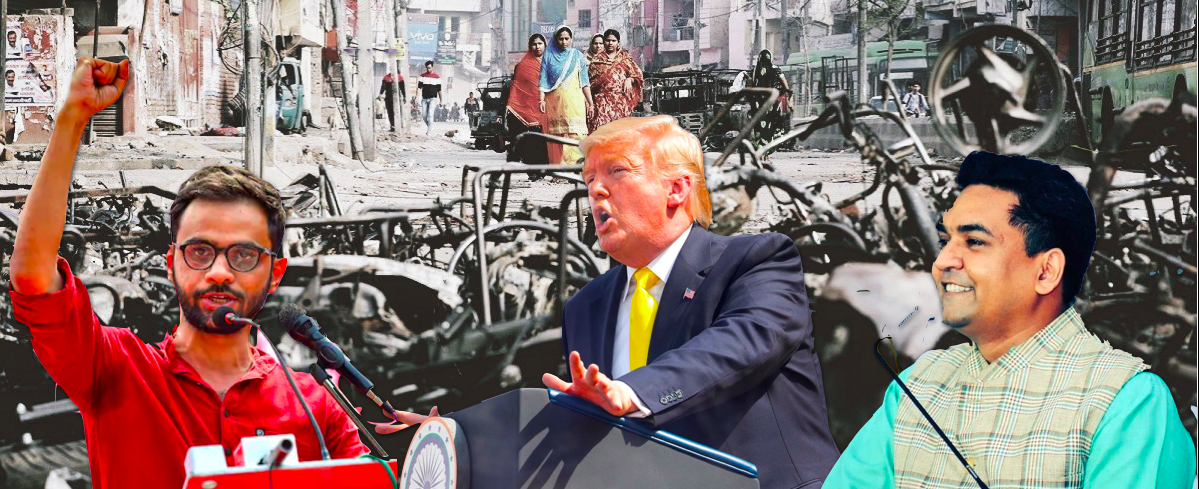After Delhi Police Gaffe on Trump Chronology, Riots Chargesheet Takes U-Turn on Conspiracy Date
Claim of January 8 plot to time riots with Trump’s visit dropped, Delhi Police now says entire anti-CAA protest was part of ‘terrorist’ plot to engineer large-scale riots ‘at suitable time’, with the ‘conspirators’ seeking to ‘reclaiming… turf’ lost as a result of BJP’s victory in 2019 elections.
The 2,695 page chargesheet filed by the Delhi Police last week repeats all the claims made in earlier chargesheets about the role of the anti-CAA movement in the February 2020 riots, with one crucial exception: investigators have dropped their embarrassing assertion that the conspiracy to trigger violence in northeast Delhi during the visit to India of US President Donald Trump was hatched in a meeting on January 8, 2020.
That claim – made in two chargesheets which have already been filed in cases relating to FIR 65/2020 and FIR 101/2020 – was patently false, because the very idea of a Trump visit was first reported only on January 13.
The January 8 plan, the police had said, was aimed at “defaming the country in the international arena” and shaking the Central government on the issue of the Citizenship (Amendment) Act and National Register of Citizens.
The police never responded to media reports about this glaring discrepancy in dates, which placed a question mark over the veracity of its others claims. However, the latest chargesheet filed by the Delhi Police Special Cell in the ‘riots conspiracy case’ registered under FIR 59/2020 has quietly dropped the ‘Trump’ angle from its description of the January 8 meeting – in which former student leader Umar Khalid, former city councillor Tahir Hussain and community activist Khalid Saifi allegedly participated – and moved this dimension of the ‘conspiracy’ to a less implausible date.
Thus, the Special Cell chargesheet – which The Wire has accessed – makes the following claim in its key section, titled ‘A Chronology of the Conspiracy’:
‘The visit of US President Donald Trump, which was known to conspirators from 14 January 2020, when it was first broken on television media, got formal schedule declared [sic] on 11.02.2020. In pursuance and furtherance of common conspiracy, a meeting of protest site leaders of Chand bagh, Mustafabad, Kardumpuri and Jafrabad was held in the intervening night of 16/17 February 2020 at 2 am. In the meeting it was decided and agreed that a coordinated blockade of traffic on roads, i.e. Chakka Jaam would be executed during the visit of President of USA, Donald Trump by the members of all the protest sites of the Northeast Delhi. Post-Chakka Jaam, all protest site members will adopt violent measures to escalate the protests. (original emphasis)
While the Delhi Police still says Khalid, Hussain and Saifi had a secret meeting in the office of the Popular Front of India at Shaheen Bagh on January 8 where it claims violence was planned, it no longer apparently believes what it had stated in its earlier chargesheets:
“In [the January 8] meeting, it was decided to have a big blast so that the Central Govt. could be shaken on the issue of CAA/NRC and so as to defame the country in the international arena. In the meeting, Umar Khalid had assured not to bother about the fund as PFI organization would also be ready to provide fund and logistics for these riots. These riots were planned to be happened during or prior to the visit of US President Donald Trump in the month of February, 2020.”
Targeting Umar Khalid for Amravati speech
The latest chargesheet, however, continues to paint Umar Khalid as a key mastermind, alleging that his February 17 speech at Amravati in Maharashtra – in which he had spoken of the need for a Gandhian movement and suggested that people come on to the streets during Trump’s visit to India to protest the Central government’s policies – was actually aimed at inciting riots in Delhi.
This charge was first levelled against Khalid and the anti-CAA movement by the Bharatiya Janata Party’s IT cell and then by Union home minister Amit Shah.
Also Read: Delhi Police Affidavit Shows Muslims Bore Brunt of Riots, Silent on Who Targeted Them and Why
The FIR 59/2020 chargesheet includes replies from two TV channels, Republic TV and TV 18 – both had shown an edited snippet of Khalid’s lengthy speech – in which they told the police they did not have any raw footage of the Amravati event and that they had obtained the clip they did show from the head of the BJP IT cell, Amit Malviya.
Noting that the police managed to obtain the original recording, the chargesheet includes a transcript of Khalid’s full speech. However, the police neither draws attention to, nor takes note of the fact that Khalid repeatedly stresses the need for non-violent protest.
Kapil Mishra’s call to come on the streets accepted as peaceful
While Khalid’s call for people to take to the streets is held by the police as incitement to violence, the chargesheet blandly accepts BJP leader Kapil Mishra’s explanations for his controversial remarks made near the Jafrabad anti-CAA protest site in northeast Delhi on February 23 just before the riots began.
BJP leader Kapil Mishra addressing supporters at Jafrabad on February 23. Photo: Twitter
Essentially Mishra had mobilised his supporters to gather at the protest site and, in the presence of the police, threatened to take the law into his own hands if the police did not force the anti-CAA protestors to leave. Soon after he spoke, clashes broke out at Jafrabad and slowly spread to others parts of northeast Delhi, taking the lives of 52 civilians, 40 of whom were Muslim, and one policeman.
The chargesheet notes that Mishra was asked by the police on July 27, “What did you mean by saying that we will disperse peacefully as long as Trump is here but after that we are not going to listen to [the police]?”
Excerpt from page 1730 of the chargesheet in fiR 59/2020.
Mishra’s reply was that his intention was only to tell the police that he too would also sit on dharna if the roadblock caused by the anti-CAA protestors was not cleared. Denying he had made a speech, he said he told the DCP, “I appeal to you to clear Jafrabad and Chand Bagh. After that, we will be forced to come on the road.”
The chargesheet contains no analysis of why Mishra’s call, made in the midst of a powder keg, for supporters to come on to the streets was peaceful, while Khalid’s Amravati speech was violent.
Also Read: How Delhi Police Turned Anti-CAA WhatsApp Group Chats Into Riots ‘Conspiracy’
Mishra’s role was not probed further, and no explanations were sought of the use his speech was put to by a Hindutva WhatsApp group whose members have been implicated in the killing of Muslims in the riots.
The chargesheet is also silent about the role of other BJP leaders like minister of state for finance Anurag Thakur, who had exhorted his supporters to go out shoot ‘traitors’ during the precise period this ‘conspiracy’ unfolded. The police claims the Delhi riots chronology goes all the way back to just before the passage of the CAA last December.
Entire anti-CAA movement part of terrorist plot
The essence of the police case is that the entire movement against the CAA – from the march by Jamia Millia students which saw the burning of buses near Friends Colony on December 15 through to the iconic sit-down protest of the Shaheen Bagh women – was from the outset a plot to promote terrorism and disruptive activity. Which is how the chargesheet justifies the invoking of charges under the Unlawful Activities (Prevention) Act against the 15 women and men accused.
The conspirators had decided in December itself to “engineer riots on a very large scale at a suitable time,” the police claims. “The date of 14th January 2020, when the impending visit of US president Donald Trump came into public domain through television, gave the precipitating stimulus for the execution of the conspiracy.”
Also Read: I Would’ve Arrested Anurag Thakur, Kapil Mishra: Ex Delhi Top Cop Ajay Raj Sharma on Riots
Based on a selective reading of chats on activist WhatsApp groups and the testimony of dozens of named and anonymous witnesses – many of whose statements share verbatim passages with one another, a tell-tale sign of prompting by investigating officers – the police has built its plot line around a simple proposition: the riots were triggered by a calculated decision to block the road at Jafrabad and other protest sites aimed at pitting Hindus against Muslims with the goal of embarrassing the Modi government and forcing it to scrap the CAA-NRC.
Holes in the plot line
There are lots of holes and contradictions in this storyline that are bound to come up during the trial but here’s one. The chargesheet claims that the Delhi Protests Support Group – essentially a WhatsApp group run by the filmmaker Rahul Roy – was the brain behind the blocking of roads and hence the riots. No proof of the DPSG’s involvement in the road block is given other than the fact that its members debated its merits as the situation at Jafrabad unfolded. While none of the members appears to have advocated a roadblock, one DPSG participant who strenuously questioned the chakka jaam was Banojyotsana Lahiri. The police chargesheet appreciates her stand, but doesn’t let on that she is in fact Umar Khalid’s partner. So how come Khalid is meant to be the prime conspirator behind the road block while his partner argues fiercely that any road block would be counter-productive?
In any case, even if one accepts the tendentious argument that the road block led to violence at the spot because ‘pro-CAA’ crowds had assembled to confront them, the geography and dynamics of the violence which unfolded over three days make it clear there were other players at work, including the police, who have been credibly accused of bias and partisanship.
Also Read: Delhi Police Chargesheet Misses Key Fact: Riots Killed the Anti-CAA Protest
Apart from treating the anti-CAA movement as a terrorist conspiracy, the chargesheet goes one step further, accusing the ‘conspirators’ of wanting to trigger violence as a means of ‘reclaiming’ the turf they had lost because of Narendra Modi’s re-election as prime minister last May:
“From the day that the results of the 2019 parliamentary elections were declared, the tone and tenor of the public utterances of the key conspirators of the present case has shown a clear streak of affinity towards violence which had started playing out in their minds. This affinity for violence as the only option left for reclaiming the lost turf for some and creating a new turf for others was the bedrock on which bridges of minds were constructed.
“The enactment of CAA and NRC gave the critical mass that the key conspirators were looking at – it presented itself as the last opportunity to give shape to the streak of mental violence that had brought them closer than ever before. Whatever followed was a result of this criminal conspiracy to commit violence…” (emphasis added)
If the Delhi Police’s focus on ‘mental violence’ and the ‘affinity towards violence …playing out in [the conspirators’] minds’ seems reminiscent of thoughtcrime, the chargesheet leaves one in no doubt: “the mere factum that there was a conspiracy to engineer riots is a substantive offence, good enough to prosecute and bring to justice the accused”, it says, “even if the riots and associated large-scale violence would have never taken place.”






